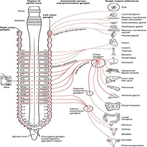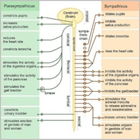Difference Between the Sympathetic and Parasympathetic Nervous SystemThe central nervous system made up of the spinal cord and the brain itself controls our body. The nervous system as a whole, which is divided into two divisions, is controlled by our brain. The nerve cells that branch out from the brain and spinal cord, make up the peripheral nervous system. The autonomic and somatic nervous systems are additional divisions of the peripheral nervous system. The sympathetic nervous system is in charge of regulating how the body reacts to perceived threats and activating the "fight or flight" reaction, whereas the parasympathetic nervous system is in charge of maintaining homeostasis and triggering the "rest and digest" response. A self-regulating system that is part of the peripheral nervous system is the autonomic nervous system. As a result, it essentially controls the environment inside the body by communicating orders to the organs through the peripheral nervous system in order to maintain vital physical processes. The autonomic nerve system (ANS) regulates the actions of different involuntary muscles, including smooth and cardiac muscles, as well as organs, glands, and other bodily functions. The ANS is divided into two sections:
What is Sympathetic nervous system?
The autonomic nervous system consists of two components, the second of which is the sympathetic nervous system. It is made up of a neural network made up of long postganglionic neurons that extend from ganglia located near the thoracic and lumbar portions of the spinal cord and short preganglionic axons that reach to ganglia nearby. So, sympathetic efferent neuron fibres also relate to thoracolumbar outflow. The sympathetic nervous system's primary job is to mobilise the body quickly to escape danger and to get it ready for emergency circumstances. The sympathetic nervous system, to put it simply, regulates the body's "fight or flight" reactions to danger. The sympathetic nervous system (SNS) is a component of the autonomic nervous system (ANS), which prepares the body to react to stressful conditions and is perpetually functioning at the basic level to maintain homeostasis. The spinal cord's thoracic and lumbar sections are affected. The fight-or-flight response often referred to as the sympathoadrenal response, is a neural and hormonal reaction to stress that is mediated by the SNS. Pre-ganglionic sympathetic nerve fibres that terminate at the adrenal medulla cause acetylcholine to be released, activating adrenaline and noradrenaline. Adrenaline makes it easier to take immediate physical action to get the body ready for powerful muscular actions. Almost all of the body's organs are innervated by sympathetic nerve fibres. The efferent neural impulses elevate the rate and reduce the gastrointestinal tract and urinary output motility. In addition, they enlarge the bronchial tubes, narrow the blood vessels, and enlarge the pupil of the eye. Sensations including heat, pressure, and pain are also transmitted via afferent neurons. What is Parasympathetic nervous system?
As a component of the autonomic nervous system (ANS), the parasympathetic nervous system (PSNS) reduces the heart rate and relaxes the muscles. At the midpoint of the spinal cord, the PSNI's nerves begin. The PSNS operates more slowly than the sympathetic nervous system, which is in contrast to that system's action. In addition to stimulating faeces, the PSNS also increases salivation, digestion, urine, and lacrimation. The PSNS functions are carried out by the neurotransmitter acetylcholine. Acetylcholine is released when pre-ganglionic nerve fibres are stimulated, and it interacts with the post-ganglionic neurons' nicotinic receptors to activate them. Acetylcholine is released when pre-ganglionic nerve fibres are stimulated, and this acetylcholine interacts with post-ganglionic neurons' nicotinic receptors. Acetylcholine is again released when post-ganglionic receptors are stimulated, and this acetylcholine interacts with the target organ's muscarinic receptors. Similarities
Differences1. Origin The sympathetic nervous system is derived from the cranial, thoracic, and lumbar portions of the central nervous system. The parasympathetic nervous system is derived from the cranial and sacral areas of the central nervous system. 2. Function The sympathetic nervous system primes the organism for vigorous physiological action. By blocking high-energy functions, the parasympathetic nervous system relaxes the body. 3. Response The sympathetic nervous system is responsible for fast reactions. Slow response is the hallmark of the parasympathetic nervous system's function. 4. The ganglion's location Ganglions of the sympathetic nervous system can be found nearby the central nervous system. Ganglions of the parasympathetic nervous system is located near the effector but away from the central nervous system. The sympathetic nervous system contains short pre-ganglionic fibres. Pre-ganglionic fibres are lengthy in the parasympathetic nervous system. The sympathetic nervous system has long post-ganglionic fibres. Post-ganglionic fibres in the parasympathetic nervous system are small in size. 5. Number of post-ganglionic fibres The sympathetic nervous system contains a significant number of post-ganglionic fibres. An insignificant amount of post-ganglionic fibres are present in the parasympathetic nervous system. 6. Area Of effect The sympathetic nervous system is widespread throughout the body. The parasympathetic nervous system is a segment of the body's nervous system. A dispersed effect is produced at the target location by the sympathetic nervous system. 7. Mode of effect The parasympathetic nervous system causes a localised effect in the area it is intended to affect. The sympathetic nervous system causes noradrenaline to be released at the effector. The parasympathetic nervous system causes the effector to release acetylcholine. 8. Effect of homotropy The sympathetic nervous system produces an excitatory, homeostatic impact. An inhibitory homeostatic impact is produced by the parasympathetic nervous system. 9. Influence on heart rate, blood pressure, and metabolic rate The sympathetic nervous system raises blood pressure, metabolic rate, and heart rate. The parasympathetic nervous system lowers blood pressure, metabolic rate, and heart rate. 10. An impact on sensory awareness Sympathetic Nervous System: This system increases sensory awareness. The parasympathetic nervous system brings back normal levels of sensory awareness. 11. Influence on the eye's pupil The eye's pupil widens thanks to the sympathetic nervous system. The parasympathetic nervous system causes the pupil of the eye to dilate. 12. Effect on saliva secretion The sympathetic nervous system prevents saliva from secreting. The parasympathetic nervous system causes saliva to secrete. 13. Effect on pulmonary system The bronchial tubules are enlarged by the sympathetic nervous system. The bronchial tubules are constricted by the parasympathetic nervous system. 14. Anxiety release The sympathetic nervous system causes the adrenal glands to release adrenaline. The parasympathetic nervous system has no effect on the adrenal gland. 15. Digestion-related effect The activity of the digestive system is increased by the sympathetic nervous system. The activity of the digestive system is reduced by the parasympathetic nervous system. 16. Glycogen degradation is affected The sympathetic nervous system speeds up the breakdown of glycogen. Glycogen oxidation is unaffected by the parasympathetic nervous system. 17. Impact on the rectum and output of urine The sympathetic nervous system constricts the rectum and lowers urine output. Increased urine flow and a relaxed rectum are both effects of the parasympathetic nervous system. ConclusionAnimals' bodies have two parts that make up the autonomic nervous system: the sympathetic and parasympathetic nervous systems. The centre of the spinal cord is where the PSNS and SNS both begin. The SNS begins in the thoracic and lumbar areas. The fight-or-flight response, which is induced by stress, is prepared by the SNS. The PSNS, in contrast, regulates the body's natural activities and helps it to become relaxed. As a result, the influence they have on regular bodily functions is the primary distinction between the sympathetic and parasympathetic neural systems. When there is a threat, the sympathetic nervous system regulates the body. It regulates the body's "fight or flight" reactions, to put it simply. The parasympathetic nervous system, on the other hand, is in charge of the body's "rest and digest" processes
Next TopicDifference between
|
 For Videos Join Our Youtube Channel: Join Now
For Videos Join Our Youtube Channel: Join Now
Feedback
- Send your Feedback to [email protected]
Help Others, Please Share










